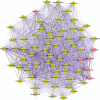Screening the key microRNAs and transcription factors in prostate cancer based on microRNA functional synergistic relationships
- PMID: 28072703
- PMCID: PMC5228663
- DOI: 10.1097/MD.0000000000005679
Screening the key microRNAs and transcription factors in prostate cancer based on microRNA functional synergistic relationships
Abstract
Prostate cancer (PC) is a common neoplasm, and metastatic PC remains incurable. The study aims to screen key microRNAs (miRNAs) and transcription factors (TFs) involved in PC.The miRNA expression profile dataset (GSE45604) was downloaded from Gene Expression Omnibus database, including 50 PC and 10 normal specimens. Differentially expressed miRNAs (DEmiRNAs) were identified through limma package in R, and DEmiRNA-DEmiRNA co-regulation network was constructed based on the number of co-regulated target genes. Functional enrichment analysis of co-regulated target genes was performed using clusterProfiler package in R, and miRNA interactions sharing at least 1 functional term were used to construct a DEmiRNA-DEmiRNA functional synergistic network (MFSN). Based on Transcriptional Regulatory Element Database, cancer-related TFs which were co-regulated by DEmiRNAs were utilized to construct a DEmiRNA-TF regulation network.A total of 66 DEmiRNAs were identified, including 7 up-regulated miRNAs with 18,642 target genes and 59 down-regulated miRNAs with 130,694 target genes. Then, the DEmiRNA-DEmiRNA co-regulation network was constructed, including 66 DEmiRNAs and 2024 co-regulation relationships. In MFSN, hsa-miR-1184, hsa-miR-1207-5p, and hsa-miR-24 had significant functional synergistic relationships. The DEmiRNA-TF network contained 6 up-regulated DEmiRNAs and 4 of them were highlighted, as hsa-miR-1184, hsa-miR-1207-5p, hsa-miR-182, and hsa-miR-183. In subnetwork of the 4 miRNAs, peroxisome proliferative activated receptor, alpha (PPARA) and cyclic AMP-responsive element modulator (CREM) were the critical regulated TFs.Four up-regulated miRNAs (hsa-miR-1207-5p, hsa-miR-1184, hsa-miR-182, and hsa-miR-183) and 2 TFs (PPARA and CREM) were identified as key regulators in PC progression. The above 4 miRNAs might participate in PC progression by targeting PPARA and CREM.
Conflict of interest statement
The authors have no conflicts of interest to disclose.
Figures





Similar articles
-
The potential of microRNAs as human prostate cancer biomarkers: A meta-analysis of related studies.J Cell Biochem. 2018 Mar;119(3):2763-2786. doi: 10.1002/jcb.26445. Epub 2017 Dec 4. J Cell Biochem. 2018. PMID: 29095529 Free PMC article. Review.
-
Serum miR-1181 and miR-4314 associated with ovarian cancer: MiRNA microarray data analysis for a pilot study.Eur J Obstet Gynecol Reprod Biol. 2018 Mar;222:31-38. doi: 10.1016/j.ejogrb.2018.01.006. Epub 2018 Jan 9. Eur J Obstet Gynecol Reprod Biol. 2018. PMID: 29353130
-
Potential Common Molecular Mechanisms Between Periodontitis and Prostate Cancer: A Network Analysis of Differentially Expressed miRNAs.In Vivo. 2025 Mar-Apr;39(2):795-809. doi: 10.21873/invivo.13863. In Vivo. 2025. PMID: 40010958 Free PMC article.
-
Identification of key miRNAs and mRNAs related to coronary artery disease by meta-analysis.BMC Cardiovasc Disord. 2021 Sep 16;21(1):443. doi: 10.1186/s12872-021-02211-2. BMC Cardiovasc Disord. 2021. PMID: 34530741 Free PMC article.
-
Discovering the signature of a lupus-related microRNA profile in the Gene Expression Omnibus repository.Lupus. 2020 Oct;29(11):1321-1335. doi: 10.1177/0961203320944473. Epub 2020 Jul 28. Lupus. 2020. PMID: 32723063 Review.
Cited by
-
Hsa-miR-183-5p Modulates Cell Adhesion by Repression of ITGB1 Expression in Prostate Cancer.Noncoding RNA. 2022 Jan 18;8(1):11. doi: 10.3390/ncrna8010011. Noncoding RNA. 2022. PMID: 35202085 Free PMC article.
-
The microRNA cluster miR-30b/-30d prevents tumor cell switch from an epithelial to a mesenchymal-like phenotype in GBC.Mol Ther Methods Clin Dev. 2020 Dec 3;20:716-725. doi: 10.1016/j.omtm.2020.11.019. eCollection 2021 Mar 12. Mol Ther Methods Clin Dev. 2020. PMID: 33738326 Free PMC article.
-
The potential of microRNAs as human prostate cancer biomarkers: A meta-analysis of related studies.J Cell Biochem. 2018 Mar;119(3):2763-2786. doi: 10.1002/jcb.26445. Epub 2017 Dec 4. J Cell Biochem. 2018. PMID: 29095529 Free PMC article. Review.
-
Expression of Transcription Factor CREM in Human Tissues.J Histochem Cytochem. 2021 Aug;69(8):495-509. doi: 10.1369/00221554211032008. Epub 2021 Jul 14. J Histochem Cytochem. 2021. PMID: 34261344 Free PMC article.
-
[High expression of CREM is associated with poor prognosis in gastric cancer patients].Nan Fang Yi Ke Da Xue Xue Bao. 2024 Sep 20;44(9):1776-1782. doi: 10.12122/j.issn.1673-4254.2024.09.18. Nan Fang Yi Ke Da Xue Xue Bao. 2024. PMID: 39505346 Free PMC article. Chinese.
References
-
- Varambally S, Dhanasekaran SM, Zhou M, et al. The polycomb group protein EZH2 is involved in progression of prostate cancer. Nature 2002;419:624–9. - PubMed
-
- Barbieri CE, Demichelis F, Rubin MA. Molecular genetics of prostate cancer: emerging appreciation of genetic complexity. Histopathology 2012;60:187–98. - PubMed
-
- Cavalieri EL, Devanesan P, Bosland MC, et al. Catechol estrogen metabolites and conjugates in different regions of the prostate of Noble rats treated with 4-hydroxyestradiol: implications for estrogen-induced initiation of prostate cancer. Carcinogenesis 2002;23:329–33. - PubMed
MeSH terms
Substances
LinkOut - more resources
Full Text Sources
Other Literature Sources
Medical
Miscellaneous

